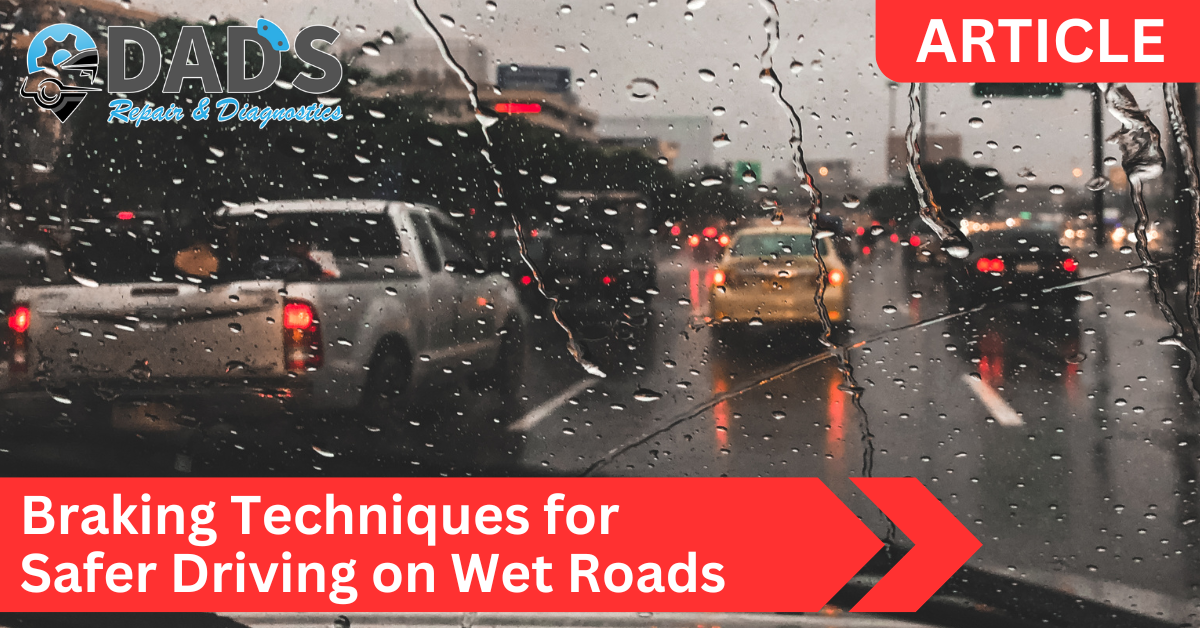The first big rain after a long dry spell in Madera always seems to catch people off guard. Roads become slick, visibility drops, and stopping distances increase dramatically. That’s why understanding proper braking techniques on wet roads isn’t just helpful — it’s critical for safety.
At DADS Auto Repair in Madera, CA, we’ve seen countless brake systems damaged or underperforming because drivers didn’t realize how much wet conditions change the way brakes behave. Whether you’re driving through a light drizzle or a downpour, how you brake can make all the difference between stopping safely and sliding through an intersection.
In this article, we’ll talk about how your braking system works, how rain affects it, and what you can do to stay safe, efficient, and in control.
Why Wet Roads Are So Dangerous
When the first few rains hit after a dry spell, the roads in the Central Valley can turn into a slippery mix of oil, dirt, and water. That combination dramatically reduces traction. Even vehicles equipped with anti-lock brakes (ABS) or all-wheel drive can lose grip if braking is done too hard or too late.
Water creates a thin film between the tires and the pavement — a condition called hydroplaning — where your tires literally float on top of the water instead of gripping the road. Once that happens, your steering and braking are both compromised.
That’s why understanding how and when to brake makes such a difference. Good braking habits, combined with well-maintained brake pads, rotors, and calipers, give you the best chance to stay in control.
The Science Behind Braking
Braking is all about converting motion into heat. When you press the brake pedal, hydraulic pressure travels through the brake lines, pushing the brake calipers to squeeze the brake pads against the brake rotors. The friction between them slows the wheel down, and the vehicle comes to a stop.
On a dry road, that process happens smoothly because your tires have strong grip. On a wet surface, however, that grip is reduced, which means your brakes must work harder — and your reaction time needs to be quicker.
Even though modern systems like anti-lock brakes help prevent wheel lockup, they can’t overcome poor habits or neglected maintenance. That’s why technique and system health go hand-in-hand.
Braking Techniques That Keep You Safe
When the pavement is wet, the goal is simple — maintain traction and avoid sudden weight shifts that cause the tires to lose grip. The following techniques can help you do just that.
Slow Down Before You Need to Stop
The biggest mistake we see drivers make in wet conditions is waiting too long to brake. Your stopping distance can double or even triple in the rain. That means you need to start braking earlier, especially when approaching lights, intersections, or stopped traffic.
Instead of jamming the pedal at the last second, ease into it gradually. This allows your tires to maintain grip and your anti-lock brakes to work more effectively if they’re needed.
Apply Gentle, Steady Pressure
Smoothness is key. Abrupt inputs upset your car’s balance and make the tires more likely to lose traction. Instead of slamming the brakes, use gentle, steady pressure. Let the car slow down progressively.
You should feel the car settle as you brake, not pitch forward dramatically. That balance keeps all four tires working together instead of overloading the front ones.
Keep Your Distance
Following distance is critical when it’s wet. On dry pavement, three seconds of space between you and the vehicle ahead is usually enough. In the rain, double it — or more if visibility is low.
That extra distance gives your brakes the time they need to do their job without forcing you into a panic stop. Even the best brake pads and rotors can’t save you if you don’t have enough space.
Use the Anti-Lock Brakes Correctly
Modern vehicles come equipped with anti-lock brakes (ABS), which automatically prevent your wheels from locking up during hard braking. When ABS activates, you’ll feel a pulsing in the brake pedal. That’s normal — it’s the system rapidly applying and releasing pressure to maintain traction.
The correct response? Keep your foot on the brake. Don’t pump the pedal. Let the system do its work. It’s designed to keep you steering while stopping, even on wet pavement.
Avoid Cruise Control in the Rain
This one surprises a lot of people. Cruise control can actually increase your risk on wet roads. If your tires start to hydroplane while cruise control is on, your vehicle may accelerate suddenly when the tires regain contact — causing you to lose control.
Always drive manually in wet conditions. It gives you faster, more precise control of braking and throttle.
Brake Before Entering a Curve
When the road is wet, braking while turning is one of the fastest ways to lose traction. Always brake before entering a curve, not during it.
By slowing down first and then gently steering through, you keep your tires balanced and gripping evenly. If you brake mid-turn, the weight shift can cause a skid that even ABS can’t correct easily.
Keep an Eye on Tire Condition
Good brakes are only half the equation — your tires matter just as much. Bald or worn tires can’t channel water away efficiently, which means your braking performance drops sharply in wet conditions.
Check your tread regularly and replace tires when they reach 4/32″ or less. Even a brand-new set of brake pads won’t stop you quickly if your tires can’t maintain contact with the road.
Maintenance Makes the Difference
Even with perfect technique, your brakes need to be in top shape to perform well on wet roads. Here’s where proper maintenance at DADS Auto Repair comes in.
Brake Pad and Rotor Condition
Worn brake pads can reduce stopping power dramatically, especially in the rain. As they thin out, they lose the ability to bite evenly against the rotors, causing longer stops and uneven braking.
If you ever hear squealing or grinding, it’s time to get your brakes inspected. That noise often means the pads are worn down to the metal, which can quickly damage the rotors and calipers.
Brake Fluid and Brake Flush Service
Your brakes rely on hydraulic pressure to function, and that pressure comes from brake fluid. Over time, moisture can contaminate the fluid, leading to a soft or spongy pedal.
That’s why we recommend a brake flush every two to three years. A flush removes old, moisture-laden fluid and replaces it with clean, high-quality fluid that maintains consistent pressure and resists boiling under heavy use.
Calipers and Hardware
Your brake calipers and hardware need occasional inspection too. Sticking or seized calipers can cause uneven wear and reduce braking efficiency. When we perform a brake inspection at DADS, we always check caliper slides, pistons, and brackets to make sure everything is moving freely.
Anti-Lock Brake System Check
Your anti-lock brakes depend on sensors and electronics that should be inspected periodically. If your ABS light is on, don’t ignore it — it means the system is disabled, leaving you without that safety net in wet or slippery conditions.
A quick diagnostic test can reveal if it’s a faulty sensor, a wiring issue, or a hydraulic problem.
Driving Habits That Help Your Brakes Last Longer
Even outside of rainy weather, good habits can make your brake system last longer and perform better when you need it most.
- Avoid riding the brakes downhill — use engine braking instead.
- Plan your stops early to prevent heat buildup in the rotors.
- Don’t overload your vehicle; extra weight increases stopping distance.
- Get periodic inspections — especially before winter or a long trip.
At DADS Auto Repair in Madera, we take the time to look beyond just replacing parts. We diagnose the root cause of brake wear so your system performs efficiently and safely.
Why Proper Braking Saves More Than Just Your Brakes
Learning good braking habits isn’t just about staying safe — it’s also about efficiency and cost. Smooth braking saves your brake pads and rotors from unnecessary wear, extends tire life, and even improves fuel economy.
It also keeps your anti-lock brakes, calipers, and hydraulic system in better condition by reducing heat and stress. Over time, that adds up to fewer repairs and more reliable stopping power when it matters most.
Stay Safe with DADS Auto Repair
Rainy weather can turn a normal drive into a challenge, but with proper braking techniques and a well-maintained brake system, you’ll have the confidence to handle it safely.
If your brakes squeal, vibrate, or don’t feel as strong as they used to, stop by DADS Auto Repair in Madera, CA. Our technicians specialize in diagnosing brake issues accurately — from worn brake pads and rotors to hydraulic leaks and anti-lock brake problems.
Remember our motto: We Diagnose, We Don’t Guess.
We’ll make sure your vehicle’s brakes are performing exactly how they should, so you can drive confidently — rain or shine.


